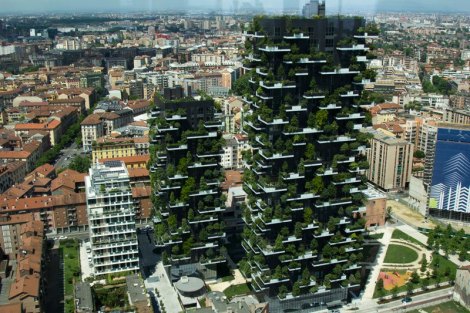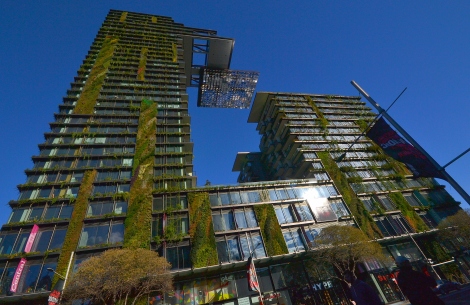Living in a vertical forest might be the residential way of the future!
A major challenge for city planners is how to provide both the urban densification required for a growing population (and less sprawl), AND the green space we need for our own wellbeing, to provide habitat for our local critters, and to combat the Urban Heat Island effect.
Well some clever Italians in Milan might provide us with one solution: Vertical Forests.

Vertical forest residential towers in Milan, Italy. Source: http://www.twistedsifter.com © Boeri Studio
The Bosco Verticale (Vertical Forest) was officially opened in October 2014 in the Porta Nuova district of Milan, Italy. The pair of residential towers are 110 m and 76 m, and host 900 trees (each measuring 3, 6 or 9 m) and over 2,000 plants from a wide range of shrubs and floral plants distributed in relation to the façade’s position towards the sun. They
The Vertical Forest equals approximately 1 Ha of woodland on earth, and creates its own microclimate, producing humidity and O2, and absorbing CO2 and dust particles. Given Milan is one of Europe’s most polluted cities, its features have a particularly significant impact.

Source: http://www.twistedsifter.com © Boeri Studioc
Tree species were very carefully chosen to fit with their positioning on the facades in terms of height, and unsurprisingly, it took a team including botanists and horticulturalists two years to design!
The plants used in this project were grown specifically for the purpose of the residential block and were pre-cultivated, made to slowly get used to the conditions (position, wind, contained roots) they would be placed in on the building.
There are most certainly challenges and costs associated with the Vertical Forest concept, including the relatively higher costs related to capital and maintenance, as well as additional structural requirements due to the higher load that the building has to sustain. Indeed, it will be interesting to see how the vertical forest is faring in 5-10 years. However, if cities, developers, and builders are willing to invest in this technology, the beneficial cooling and heat gains (particularly if choosing deciduous trees), and social and ecological values would compensate for the additional costs, particularly as the technology improves and becomes more widespread (granted it is still in its infancy).
The Boeri Studio responsible for the towers won both the prestigious International Highrise Award in 2014, and the Best Tall Building Worldwide in 2015 at the 14th Annual Council on Tall Buildings and Urban Habitat International Best Tall Building Awards.
Now the firm is taking the Vertical Forest concept over to Switzerland, with a 117 m tower planned to overlook Lake Geneva named La Tour des Cedres or The Tower of Cedars. The apartment building will house more than 100 trees made up of four varieties of cedar trees, as well as shrubs and plants across a 3000 m2 area. Construction on the new 36-storey building in Switzerland is expected to begin in 2017.
Over in Australia, One Central Park in Sydney is an example of a 117 m residential apartment complex featuring vertical gardens/green walls comprised of 250 species of Australian flowers and plants.

One Central Park, Sydney
The rise of Vertical Forests also coincides with the rise of vertical farms, which serve as a testament to the world’s shrinking supply of fertile ground.
While green walls and roofs are becoming more popular in Perth, perhaps one day we will have our own ‘Tower of Eucalypts’ as our population heads towards 3.5 million. Isn’t that an exciting idea!

Would love to see the true lifecycle cost of this adventure including design, construction and maintenance/replacement as against providing open space
Agreed! We will have to look into this data, particularly in a few years time.
Reblogged this on The Independent Advisor and commented:
Interesting concept, good to see some pilot buildings. Wonder what would happen in the event of earthquake or huge winds?